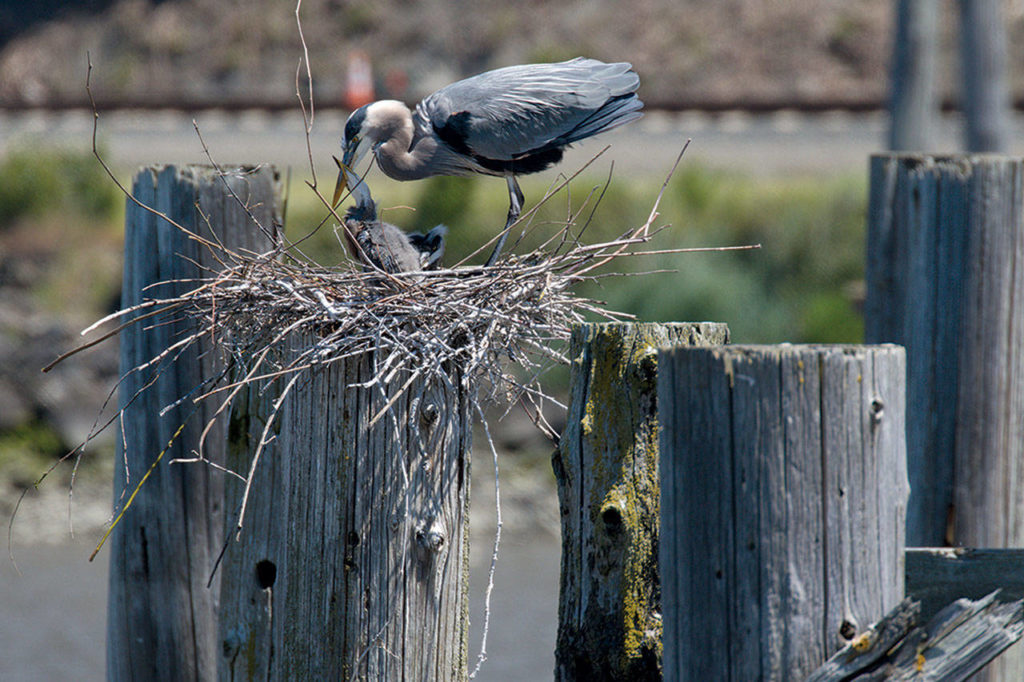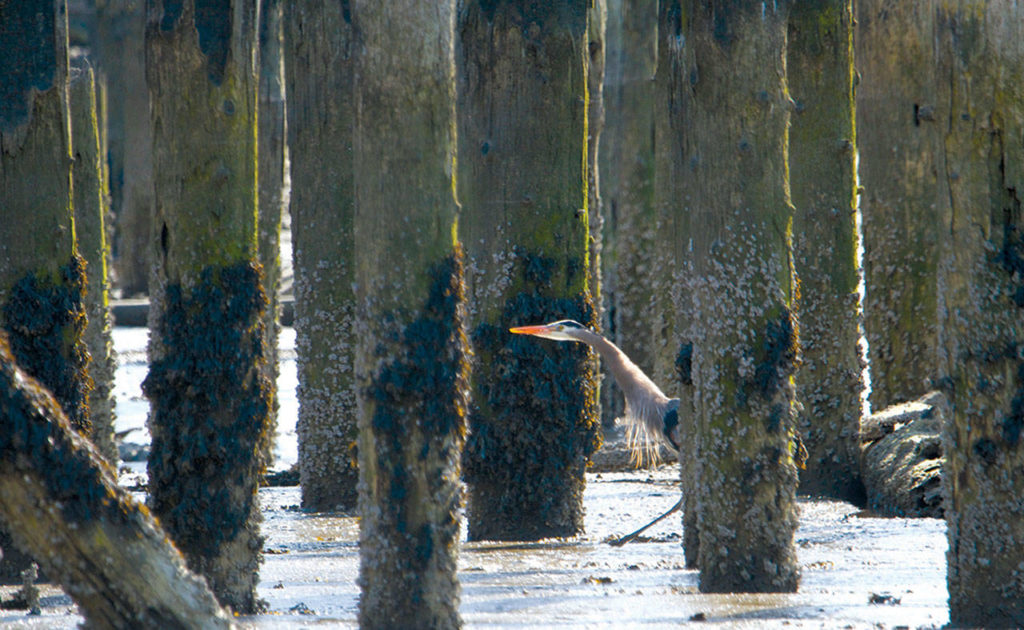For years, I’ve wanted to photograph nesting great blue herons. Herons are neat birds and they’re beautiful in flight. Their slow, deliberate wing beats make them appear to move in slow motion, especially as they maneuver their way through a colony of nests filled with young herons.
Great blue herons are one of the most easily recognized birds in Washington. Large, gawky and with a bent neck and long legs, they can turn on a dime from patient, motionless stalkers to lightning-fast predators. They do most of their foraging along rivers and lakes, or in wet meadows, waiting for prey to come by.
Unlike many birds, they typically raise their young in colonies, often building their nests near other heron pairs in trees, as high as 100 feet above the ground. So I was pretty excited when I heard of a nesting colony of herons, called a rookery or heronry, along the Everett waterfront.
For the past several years, these birds have built nests on top of pilings that can be seen from the Port of Everett Marina parking lot at 10th Street.
In some areas, heron colonies can grow into hundreds of birds, but this one only has a few dozen. That’s probably a good thing, because large colonies can attract predators such as bald eagles, which will attack the nests and eat the young. That hasn’t been the case in Everett.
In Washington, the birds nest once a year. In warmer areas, it might be twice. The males pick the nesting sites in February and March, and the females choose their mate. The males gather most of the nesting materials, and the females arrange the nest. Often nests are reused, so it’s more of a case of just adding some new sticks.
The females lay two to six eggs. Both parents incubate the eggs. Together, the herons raise the young after the pale-blue eggs hatch in just under a month.
The baby herons stay in the nest for about 60 days until they can fly. Unlike their parents, who sport a shaggy ruff at the base of their necks and a black eyebrow that extends back to black plumes emerging from the head, juveniles have a dark crown with no plumes or ruff, and a mottled neck.
For the past few years, I’ve spent quite a few hours watching the herons raise their young. The rookery along the waterfront is a great location because the adults don’t have to go very far to find food.
Herons have a varied diet: snakes, amphibians, small fish, other birds and small mammals such as rodents. They spend about 90% of their time watching and wading along waterways and picking up available food along the way.
Most of the herons in the rookery fly a short distance away and patrol the mudflats, snatching small fish out of the water with their dagger-like beaks.
The herons return to their nest every few hours, feeding their young by regurgitating their catch, often putting the food right into their babies’ mouths. Or they will drop it at their feet. The young herons encourage their parents to feed them by gnawing on their parent’s beak. And as the youngsters mature, the adults show up less frequently with food.
The males frequently return with more than food. They will bring sticks to add to the nest, usually presenting them to the female to do the actual arranging.
The presentations are fun to watch, because the awkward-looking adult herons are careful and cautious with babies in the nest, often hovering and descending carefully like hummingbirds to ensure they don’t jostle the young birds.
Adult herons have wingspans of about 6 feet. So adding a stick that’s several feet long can make a careful landing more difficult than it sounds. As the babies grow and take up more and more of the nest, the adults will often land on a nearby piling.
While female herons choose partners to help raise their young, the pairings do not endure. They find new mates every breeding season. Herons live around 15 years, although the oldest on record was 24 years old.
When observing great blue heron rookeries, keep in mind that you should remain at least 1,000 feet away, to avoid disturbing the birds. If that happens, the herons can abandon their nests.
We have a nice thing going on the Everett waterfront. I look forward to watching great blue herons breed there for generations.
Washington North Coast Magazine
This article is featured in the spring issue of Washington North Coast Magazine, a supplement of The Daily Herald. Explore Snohomish and Island counties with each quarterly magazine. Each issue is $3.99. Subscribe to receive all four editions for $14 per year. Call 425-339-3200 or go to www.washingtonnorthcoast.com for more information.
Talk to us
> Give us your news tips.
> Send us a letter to the editor.
> More Herald contact information.






























